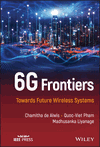6G Architectural Visions
Summary
Sixth-generation (6G) mobile network architecture is envisaged to undergo a remarkable evolution from fifth-generation to facilitate the flexible infrastructure demanded by future technologies and applications. This chapter describes how 6G evolves to be an intelligent and energy efficient network. The network architecture proposed by Letaief et al . proposes the 6G networks to be more intelligent while allowing networks to be efficient and flexible by learning network and user characteristics and dynamics. Accordingly, 6G will also evolve to be a network of subnetworks, which will be more flexible, efficient, scalable, and upgradable, banking on Artificial Intelligence capabilities. 6G networks are expected to be greener, that is, more energy-efficient, while satisfying the extreme connectivity requirements expected by future communication networks. 6G networks are envisaged to utilize a cybertwin-based network architecture toward realizing a better spectrum utilization, energy efficiency, and user experience.



